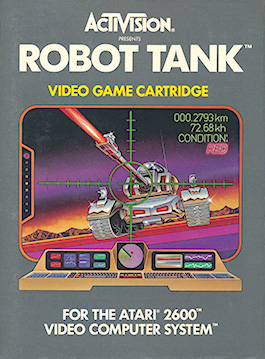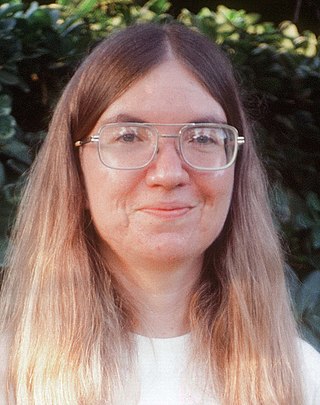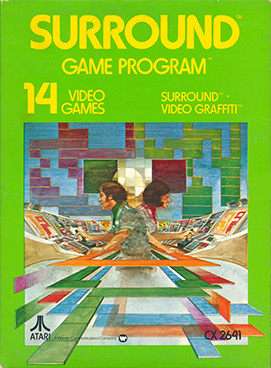
The Atari 2600 is a home video game console developed and produced by Atari, Inc. Released in September 1977 as the Atari Video Computer System, it popularized microprocessor-based hardware and games stored on swappable ROM cartridges, a format first used with the Fairchild Channel F in 1976. The VCS was bundled with two joystick controllers, a conjoined pair of paddle controllers, and a game cartridge—initially Combat and later Pac-Man. Sears sold the system as the Tele-Games Video Arcade. Atari rebranded the VCS as the Atari 2600 in November 1982 alongside the release of the Atari 5200.

Activision Publishing, Inc. is an American video game publisher based in Santa Monica, California. It serves as the publishing business for its parent company, Activision Blizzard, and consists of several subsidiary studios. Activision is one of the largest third-party video game publishers in the world and was the top United States publisher in 2016.
The video game crash of 1983 was a large-scale recession in the video game industry that occurred from 1983 to 1985, primarily in the United States. The crash was attributed to several factors, including market saturation in the number of video game consoles and available games, many of which were of poor quality. Waning interest in console games in favor of personal computers also played a role. Home video game revenue peaked at around $3.2 billion in 1983, then fell to around $100 million by 1985. The crash abruptly ended what is retrospectively considered the second generation of console video gaming in North America. To a lesser extent, the arcade video game market also weakened as the golden age of arcade video games came to an end.

Kaboom! is an action video game published in 1981 by Activision for the Atari 2600. The gameplay was based on the Atari arcade video game Avalanche (1978), with the game now involving a Mad Bomber who drops bombs instead of falling rocks. Kaboom! was programmed by Larry Kaplan with David Crane coding the graphics for the buckets and Mad Bomber. It was the last game designed by Kaplan for Activision, who left the company shortly after the release of the game. The game was later ported by Paul Wilson for the Atari 5200 system.
Alan Miller is an American video game designer who was the co-founder of the video game company Activision.

Pitfall! is a video game developed by David Crane for the Atari 2600 and released in 1982 by Activision. The player controls Pitfall Harry, who has a time limit of 20 minutes to seek treasure in a jungle. The game world is populated by enemies and hazards that variously cause the player to lose lives or points.

Combat is a 1977 video game by Atari, Inc. for the Atari Video Computer System. In the game, two players controlling either a tank, a biplane, or a jet fire missiles at each other for two minutes and sixteen seconds. Points are scored by hitting the opponent, and the player with the most points when the time runs out wins. Variations on the gameplay introduce elements such as invisible vehicles, missiles that ricochet off of walls, and different playing fields.

David Crane is an American video game designer and programmer. Crane grew up fascinated by technology and went to DeVry Institute of Technology. Following college, he went to Silicon Valley and got his first job at National Semiconductor. Through his friend Alan Miller he learned about potential video game design work at Atari, Inc. and began work there in 1977.
1980 saw the release of a number of games with influential concepts, including Pac-Man, Battlezone, Crazy Climber, Mystery House, Missile Command, Phoenix, Rally-X, Space Panic, Stratovox, Zork, Adventure, and Olympic Decathlon. The year's highest-grossing video game was Namco's arcade game Pac-Man, while the best-selling home system was Nintendo's Game & Watch. The Atari VCS also grew in popularity with a port of Space Invaders and support from new third-party developer Activision.

Robot Tank is a first-person shoot 'em up written by Alan Miller for the Atari 2600 and published by Activision in 1983. It is similar in design to Atari, Inc.'s Battlezone tank combat arcade video game and more so to its 2600 port. Robot Tank adds different systems which can individually be damaged—instead of the vehicle always exploding upon being shot—and weather effects.

Air-Sea Battle is a fixed shooter developed and published by Atari, Inc. for the Atari VCS. Air-Sea Battle is partially based on the 1975 Atari arcade video game Anti-Aircraft where each player uses a ground-based gun to shoot passing aircraft. The cartridge adds other variants, such as planes dropping bombs on ships and a carnival-themed shooting gallery.

Bowling is a sports video game published in 1979 by Atari, Inc. for the Atari VCS. It was programmed by Larry Kaplan who left Atari to co-found Activision the same year. The game is an interpretation of the sport bowling, playable by one or two players.
Robert A. Whitehead is an American video game designer and programmer. While working for Atari, Inc. he wrote two of the nine Atari Video Computer System launch titles: Blackjack and Star Ship. After leaving Atari, he cofounded third party video game developer Activision, then Accolade. He left the video game industry in the mid-1980s.

Carol Shaw is one of the first female game designers and programmers in the video game industry. She is best known for creating the Atari 2600 vertically scrolling shooter game River Raid (1982) for Activision. She worked for Atari, Inc. from 1978 to 1980, where she designed multiple games including 3-D Tic-Tac-Toe (1978) and Video Checkers (1980), both for the Atari VCS before it was renamed to the 2600. She left game development in 1984 and retired in 1990.
Games by Apollo Inc. was a third-party developer of games for the Atari 2600 video game system, based in Richardson, Texas. It was founded in October 1981 by Pat Roper as a subsidiary of his National Career Consultants (NCC). Apollo's first title was Skeet Shoot, and neither it nor the ten games that followed caught on, and the company was one of the first to declare bankruptcy as a result of the video game crash of 1983.

Atari, Inc. was an American video game developer and home computer company founded in 1972 by Nolan Bushnell and Ted Dabney. Atari was a key player in the formation of the video arcade and video game industry.

Surround is a video game programmed by Alan Miller and published by Atari, Inc. for the Atari 2600. The game plays similarly to the arcade game Blockade (1976), which allows players to navigate a continuously moving block around an enclosed space as a wall trails behind it. Every time the opposite player has their brick hit a wall, the opposing player earns a single point, with the winner being the first to collect ten points.

Street Racer is a racing video game developed for the Atari Video Computer System, later known as the Atari 2600. It was programmed by Larry Kaplan and released by Atari, Inc. in September 1977 as one of the nine Atari VCS launch titles. The game was also published by Sears for their Tele-Games product line as Speedway II.

Atari Vault is a video game collection developed byCode Mystics and published by Atari Interactive for Microsoft Windows, macOS, and Linux via the Steam client. Atari Vault contains titles from Atari, Inc. and Atari Corporation published on the Atari 2600 and arcade cabinets. dating from the 1970s, 1980s, and 1990s. The games, where possible, have been updated to include modern-day features such as local and online multiplayer and online leaderboards.













